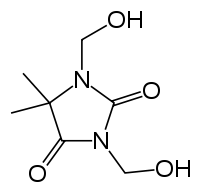DMDM hydantoin
 | |
| Names | |
|---|---|
| IUPAC name
1,3-Bis(hydroxymethyl)-5,5-dimethylimidazolidine-2,4-dione | |
| Other names
1,3-Dimethylol-5,5-dimethylhydantoin Glydant | |
| Identifiers | |
| 6440-58-0 | |
| Abbreviations | DMDMH |
| ChemSpider | 21482 |
| EC Number | 229-222-8 |
| Jmol interactive 3D | Image |
| PubChem | 22947 |
| UNII | BYR0546TOW |
| |
| |
| Properties | |
| C7H12N2O4 | |
| Molar mass | 188.18 g/mol |
| Hazards | |
| EU classification (DSD) |
|
| R-phrases | R43 |
| Except where otherwise noted, data are given for materials in their standard state (at 25 °C [77 °F], 100 kPa). | |
| | |
| Infobox references | |
DMDM hydantoin is an antimicrobial formaldehyde releaser preservative with the trade name Glydant. DMDM hydantoin is an organic compound belonging to a class of compounds known as hydantoins. It is used in the cosmetics industry and found in products like shampoos, hair conditioners, hair gels, Rite Aid Liquid Lubricant, and skin care products.[1][2]
DMDM hydantoin works as a preservative because the released formaldehyde makes the environment less favorable to the microorganisms.
Safety
A patch test study found "An increase in the use of DMDM hydantoin in cosmetic products will also inevitably increase the risk of cosmetic dermatitis in consumers allergic to formaldehyde."[3]
References
- ↑ Record in the Household Products Database of NLM
- ↑ DMDM Hydantoin at sci-toys.com
- ↑ de Groot AC, van Joost T, Bos JD, van der Meeren HL, Weyland JW (1988). "Patch test reactivity to DMDM hydantoin. Relationship to formaldehyde allergy". Contact Dermatitis 18 (4): 197–201. doi:10.1111/j.1600-0536.1988.tb02802.x. PMID 3378426.
This article is issued from Wikipedia - version of the Sunday, November 01, 2015. The text is available under the Creative Commons Attribution/Share Alike but additional terms may apply for the media files.